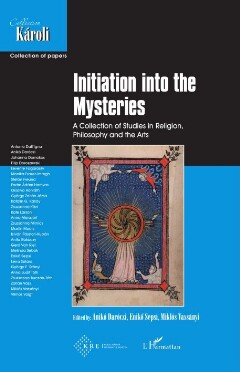Oldal 135 [135]
WORDING THE SILENCE: INITIATORY READING OF MYSTICAL TEXTS
The reader — receiver of unfathomable images through sounds — is taken up
in the same movement that occurs over and over again. The text unfolds in
a forward movement in which repetition occurs constantly, albeit in different
forms: syntactic patterns are repeated as in a litany; particular spaces or
activities of the soul are described repeatedly; speaking regularly ends in
silence. We can feel frequent circular movements. These movements are not,
however, independent of each other, but one moves further into the next,
in which the same words and word combinations appear with variations.
The result is an organically structured syntax that gives order to the
incomprehensible abstractions of which the images in this letter are made up,
enabling the reader to follow and feel that development. Each partisa reflection
of another, and while tracing one circle after another, one nevertheless does
move forward. The content of the letter can either be reduced to a few words
only — for example, to the first, introductory sentence or simply to the image
of clarity — or, alternatively, can be further expanded by means of additive
constructions. These groupings of words and the repetitive syntactic (and thus
also rhythmical) patterns convey a sense of openness, but they are structured
by the space in which they are spoken. The segmentation is expressed in an
ever repeating circularity that gives the impression of an endless movement,
where the midpoint of the concentric circles changes, through the forward
movement, into the axis of a spiral. The two fundamental movements that
characterise Letter 28 — the description of a series of successive circles and
the growth from seeds — appear together, with now the one, now the other
occupying the foreground, without any discernible rule.
The text/speech at a certain point moves to where the heavens are ‘opened
up’ (ontploken) — aword rarely used but uttered in Letter 1 where the magistra
commands the disciple to open up her eyes in clarity — and the soul is again
led into a ‘godlike clarity’ that harks back to the first sentence of the letter
— and to the very first letter of the collection. The soul sees, but as in Letter
22, which simultaneously offers an image and strips it away, this is a seeing
without seeing (134):
Thus she sees, and she sees not.
Soe siet si; / Ende sine siet niet.
God, who cannot be seen by humans, ‘gives’, and the soul can ‘receive’ (138):
She stands,
and God gives
and she receives.
Si steet, / ende god gheuet / Ende si ontfeet.
+ 133 *
Daréczi-Sepsi-Vassänyi_Initiation_155x240.indb 133 6 2020. 06.15. 11:04:17

